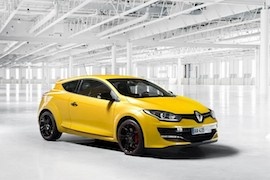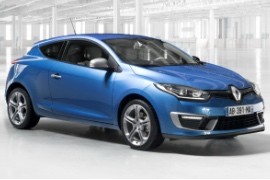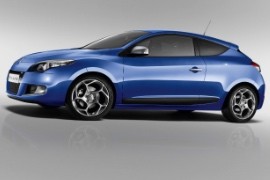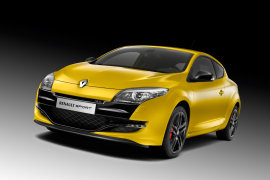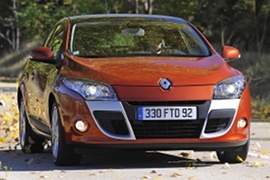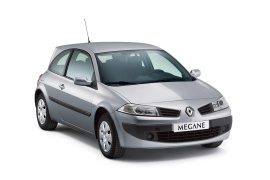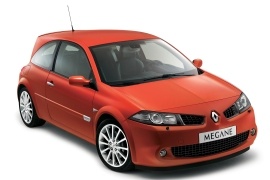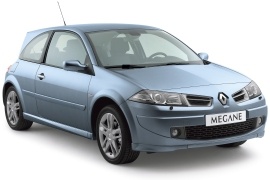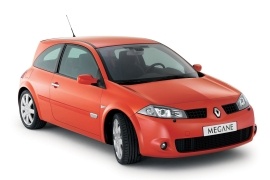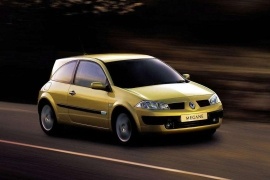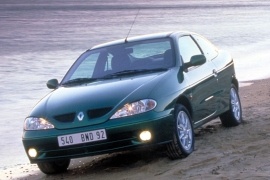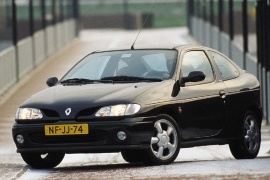RENAULT Megane Coupe Models/Series Timeline, Specifications & Photos
First production year: 1996
Engines: Gasoline, Diesel
Body style: Coupé (two-door)
Renault introduced a mid-life cycle refresh for the entire Megane range in 2013 and improved its most potent version, the RS, in the following year.
When Renault introduced the first Megane RS back in back in 2004, it became the benchmark for the hot-hatch industry. It overthrew the standards and overtook its opponents with its turbocharged engine. Its successor appeared in 2010, produced even more power, and kept winning customers for the French brand. But when the carmaker upgraded the rest of the Megane range, the RS version couldn't be left untouched.
There were not too many things to do to the car on the exterior, but the carmaker still found some areas to work on, such as the front Platine Grey F1-type blade. Another notable change for the 2014 model was the complete body-colored bumper, while its predecessor featured a piano-black center. For the daytime running lights, the carmaker installed six LEDs on each side, three more than the 2010 model.
Inside, the carmaker installed Recaro sport bucket seats for the RS Trophy version. Renault used Alcantara for the upholstery, steering wheel, and handbrake below, with red stitching even on the rear bench seat.
Under the hood, Renault offered the RS with a turbocharged 2.0-liter engine that provided 265 hp. A limited-edition Trophy version offered ten more horses, a standard limited-slip differential, and a reinforced chassis. Both versions featured a six-speed manual transmission.
The 2013 Megane Coupe GT has received a specific Malta Blue color, which was the only one available. The front bumper has been redesigned for a sportier look. The lower grille and the white headlight surrounds are specific to the GT and GT-Line cars, as are the black headlight masks.
A new set of light-alloy-wheels was available for the Coupe GT, fitted with 225/40 R18 tires. Some aluminum and dark themes were available for the vehicle as well.
Inside, in the dashboard, there is a new analog tachometer besides the digital speedometer. The white background and a very visible red zone suggest a sportier vehicle, but the overall interior updates are not so obvious. Some sportier seats with better lateral support and new color for the seatbelts were fitted as well.
For the Coupe GT Renault offered two specific engines, both with a 2.0-liter displacement and both turbocharged. The gasoline version offered 220 hp and 340 Nm (250 lb-ft) of torque, while the diesel unit had 165 hp and 380 Nm (280 lb-ft) of torque. For both engines, the only transmission available was a six-speed manual unit. Performance was good, with a 0 to 100 kph (0-62 mph) sprint in 8.8 seconds for the diesel and two seconds faster for the gasoline version. Top speed was good for both variants, with 240 kph (150 mph) for the gasoline and 215 kph (133 mph) for the diesel.
RENAULT Megane GT 3 Doors 2.0L TCe Start & Stop 6MT (220 HP)
The third generation of the Renault Megane was unveiled in 2008 as a hatchback with three or five-doors. Two years later, the French carmaker introduced the GT line.
Renault knew that if it wants to get a big chunk of the market, it had to come with a car priced lower than a German. It also had to make an Italian compact look dull next to it. Maybe the five-door version was not the best-looking compact car on the market, but the three-door version was better than its Italian competitor, the Fiat Bravo since Fiat didn't make a 3-door version for that. After two years into production, Renault tried to make things harder for its competitors and introduced the GT Line.
At the front, there was a specific bumper with a black, reshaped, lower grille. On the bumper's outer sides, the Coupe GT/GT Line featured individual housed fog lights. To amplify the aggressive effect, the Renault designers installed black headlamp backgrounds.
Inside, there were more features inspired by the sportiest hot-hatch of the moment, the Megane RS. It sported bucket seats with high bolstering on the outside. Renault installed an analog tachometer in the instrument cluster, unlike the rest of the Megane range that featured digital, LCD, ones. As for the engines, Renault installed a 2.0-liter turbocharged gasoline engine. Power went to the front wheels. For the drivetrain, the French carmaker asked the Renault Sport department to enhance the vehicle. As a result, the suspension was stiffer and the ground clearance smaller than a regular Megane Coupe.
When Renault introduced the first generation of the Megane Renault Sport, it became the ultimate hot-hatch on the market and remained there until its successor arrived in 2009.
The Renault Sport department proved that its products were from a different planet, not only postal code than the rest of the products built by the French carmaker. Not only that, the Megane RS was not bland; it was fierce and proved that beating many sports cars on the famous Nurburgring race track. It was the fastest front-wheel-drive car in the world and overtook the Lamborghini Diablo SV, the Porsche Boxster S, and the Dodge Viper GTS in the process.
Unlike its predecessor, the 2009 model featured rounded shapes all over the body, with swept-back headlights and a piano-black grille at the front flanked by the mandatory daytime driving lights. Also, Renault Sport offered a Trophy package which lowered the car even more. At the back, the car featured a tailgate with a roof spoiler at the top. Unlike the rest of the Megane Coupe range, the RS version sported a single tailpipe in the middle, under the rear bumper, flanked by a diffuser.
Inside, the carmaker installed bucket seats with an option for a sport version with integrated headrests and high bolstering on the sides. Its instrument cluster featured a white-dial tachometer and a centered black-dial speedometer, while on the left side, the carmaker installed an LCD for the onboard computer.
But the most important part of the car was underneath it. Renault Sport developed a two-liter turbocharged engine that provided 250 hp for the normal version and 265 for the Trophy one. A hard-core version named Cup was also on the offer, which came with a limited-slip differential fitted as standard.
The launch of the Renault Megane Coupe took place in September 2008 at the Paris Motor Show. Renault made a big step forward and designed a coupe that turned heads with its stylish, catchy look.
The interior of the Megane Coupe was ergonomic and very well thought out with softer materials used for the dashboard.
The driving position was very comfortable and the front seats were easily adjustable, as well as the steering wheel.
The load area in the Coupe was fairly sized and could be extended by folding the back seats flat in case users wanted to carry larger objects.
The rear seats offered limited knee-room, so the Coupe was not the most appropriate car to carry adults in the back.
The Coupe came with a standard sat-nav system and users could opt for an assisted parking brake.
Safety wise, the Megane had no less than 8 airbags and even scored 5 stars at the Euro NCAP.
The new steering system along with the stiffer suspension offered great driving in turns with no body roll and good grip.
One of the downsides that was noticed during the Coupe’s production was the soundproofing issue that arose at higher speeds. And that was a pity, because the Coupe was a really good looking car that drove unexpectedly well.
On the other hand, the Coupe had a very good price and lots of nice features.
RENAULT Megane Coupe 1.5L dCi 5MT FWD (85 HP)
RENAULT Megane Coupe 1.5L dCi 5MT FWD (90 HP)
RENAULT Megane Coupe 1.5L dCi 6AT FWD (110 HP)
RENAULT Megane Coupe 1.5L dCi 6MT FWD (105 HP)
RENAULT Megane Coupe 1.5L dCi 6MT FWD (110 HP)
RENAULT Megane Coupe 1.6L dCi 6MT FWD (130 HP)
RENAULT Megane Coupe 1.9L dCi 6MT FWD (130 HP)
Renault introduced a facelift for the Megane's second generation in 2005 and, along with the five-door hatchback, the sedan, and the station wagon, the three-door version was upgraded as well.
Starting in January 2006, Europe switched to the Euro 5 emission standards, and Renault delayed the upgrade until the last moment. Actually, the French carmaker unveiled the facelift for the Megane at the Brussels Motor Show in January. But along with the upgraded engines, the rest of the vehicle received a few touches here and there to satisfy the customers.
Renault named the three-door version as Coupe, even though it was just a regular hatchback. The front fascia received the "bird-beak" design language introduced by Patrick le Quément. The sharp shape of the grille extended by the angular headlights resembled a bird's wings. In addition, depending on the trim level, the bumpers and the doors received either black or body-colored stripes. The car's profile revealed an arched upper window line that created C-pillars thicker on the upper side and very narrow on the lower area. At the back, the tailgate featured a bump on the metallic area, while the wrap-around windscreen formed a bubble shape.
Inside, Renault struggled to keep up with the rest of the carmakers and offered, as an option, a navigation system developed together with Tom-Tom. The instrument cluster received an improved TFT display placed between the tachometer and speedometer. Even though the car was advertised as a sporty vehicle, the high seating position and minimal bolstering areas didn't confirm that, although the carmaker offered the Megane Coupe also with the RS flavor.
Under the hood, apart from the Renault Sport version, the Megane Coupe received a choice of gasoline and turbo-diesel engines, which provided more power and better fuel efficiency than their predecessors.
Less than two years after the RS' introduction on the market in September 2004, Renault refreshed the hot-hatch lineup, but most of its changes were related to the car's look.
In July 2006, the French carmaker considered upgrading the RS look along with the rest of the Megane range. But before that, in 2005, the automaker also made other changes that improved the car's performance, but these were hardly noticed.
Since the RS already sported specific body panels, Renault considered that it should replace only specific parts, which were common with the rest of the Megane range. Unlike its five-door sibling, the RS Coupe featured body-colored door mirrors. At the front, the automaker redesigned the bumper, moving the fog lamps closer to the edges of the lower grille. In the rear, there was a new set of taillights, which sported bigger reversing light lenses. Also, the apron received a redesigned grille in the back but still sported the dual, center-mounted exhaust.
Inside, the carmaker installed a full-leather interior with side bolstering fitted as standard. At the same time, it offered sports seats on the options list. Its keyless start and entry was also a standard feature. From the factory, the car came fitted with aluminum sports pedals. It was the same bench in the back as any other three-door Megane. Along with the facelift, the Megane has received a new infotainment system.
Starting with 2005, the Megane RS also received a Cup chassis, which provided a lower ground clearance, a stiffer suspension, and a limited-slip differential. Thus, even if its engine provided the same power as the non-facelifted version, it could handle better during high-speed cornering.
In January 2006, Renault introduced a facelifted version for the entire Megane range at the Brussels Motor Show. Renault prepared a special package named GT for the three-door version, which aimed at those who wanted a sportier version of the Megane but not as hard-core as the Megane RS.
Like its siblings, it featured a new pair of headlights with clear lenses and a new, wide V-shaped grille above the bumper. In addition, Renault installed a secondary grille needed for the intercooler and the AC condenser in the apron. Finally, a pair of round foglights was added as a GT range standard.
Even though it didn't look like a true hot-hatch, the Megane GT Coupe featured a few distinct design elements inspired by the RS. Thus, the flared front wheel arches and the five double-spoke, 17" light alloy wheels differed from those from the rest of the range. In addition, the blacked-out B-pillar and the arched window line created the impression of a sporty vehicle, while a dual exhaust under the rear bumper completed the image of a hot-hatch, even though it wasn't truly one.
Inside, the carmaker created a sporty ambiance, with polished aluminum pedals and high-bolstered seats. Yet the high seating position was not exactly desired by those asking for sporty compact vehicles. The silver rings around the gray dials with red needles were also inspired by the RS version.
But at the end of the day, it was more than just an aesthetic package. Under the hood, Renault offered a two-liter turbocharged gasoline version that could provide 163 hp (165 PS) or a 148 hp (150 PS) turbodiesel. Both versions were mated with a six-speed manual gearbox.
Offered with either a three- or a five-door bodywork, the Megane RS rocked the hot-hatch arena and became everyone's favorite back in 2004 when it broke the covers of the magazines.
Two years after the launch of the Megane's second generation, Renault made a surprising move and introduced a special version for it: the RS. Moreover, it was developed by the Renault Sport department, the same team that was already famous for producing the Clio RS and, of course, the Formula 1 engines.
At the front, the RS version received a different bumper than the rest of the Megane range, with a wide lower grille needed to cool the intercooler and engine. Instead of adding some overfenders on the wheel-arches, they replaced them with new ones, and the same went for the rear ones. From its sides, the windows formed an arched line that started from the A-pillars and went on to the C-pillars. In the rear, Renault Sport made a new rear bumper to complete the sporty image and installed a dual exhaust in the middle.
Inside, the carmaker installed a full-leather interior with side bolstering fitted as standard, while it offered sports seats on the options list. The handbrake looked like an airplane throttle, with the locking button on the driver's side. Its keyless start and entry was also a standard feature. From the factory, the car came fitted with aluminum sports pedals. In the back, it was the same bench as in any other three-door Megane but with leather upholstery.
Under the hood, Renault Sport proved its value and made a turbocharged 2.0-liter engine that provided 225 hp. It was mated exclusively to a six-speed manual. As an option, Renault offered a limited-slip differential, a stiffened chassis, and a lower ground clearance with the Cup option package.
Renault introduced the second generation of its compact-segment contender Megane in 2002, and from the beginning, it offered it in two body shapes: hatchback and coupe.
Since they are French, they couldn't resist naming the cars in an unusual way. For instance, this so-called "Coupe" was nowhere near such bodywork. Instead, it had three doors, a vertical tailgate, and a classic two-box design. But in fact, the car was just a three-door hatchback.
The second generation of the Megane was a far cry from its predecessor. It was penned with angular lines and sharper edges, following the new-edge design concept. At the front, the "bird-beak" signature took center stage on the grille, flanked by a pair of air intakes that evoked a pair of wings. In addition, the angular-shaped headlights with corner-mounted turn signals provided much more light than the previous Megane. From its sides, an arched line followed the front and rear windows, with an unusual shape for the C-pillars, while at the back, the vertical tailgate featured a bump under the rear window.
Renault installed a pair of bucket seats at the front, separated by a center console where the gear selector and the handbrake were mounted. The latter mimicked an airplane throttle, and that was completely weird since the handbrake served to stop a vehicle, not lunching it. For the Megane, the carmaker offered the option of a keycard instead of a regular keyfob. The card had to be inserted into a designated slot on the center stack.
Apart from the RS range, which featured a unique turbocharged powerplant, the rest of the range was quite normal and adequate for every pocket. Also, a four-speed automatic was on the options list.
Renault facelifted the entire Megane generation in 1999, preparing it for the Euro 3 emission standards, and the Coupe version was also upgraded.
When the French carmaker introduced the Megane range, it was one of the most extended on the market, produced as a coupe, a cabriolet, a hatchback, a sedan, and an MPV. It was also a successful model based on an older but reliable platform carried over from Renault 19. Its coupe version was built as a better choice than a hot-hatch, but its success was limited.
The carmaker designed the coupe's front fascia and introduced the "Bird beak" concept design with a vertical slat that divided the front grille in two halves. The headlights resembled a pair of bird eyes as well, while the wrapped-around plastic bumper featured a wide grille on the lower side flanked by two round fog lights. Despite its appearance, the Megance Coupe was a two-door vehicle. Its trunk lid opened without the rear window.
Inside, the carmaker introduced better quality materials and white dials for the instrument panel with red needles. The instrument cluster was extended over the center stack, where Renault introduced a new CD player as an option, above the climate control dials. Its bucket seats at the front were designed mostly for comfort, while in the back, there was almost no room for any person.
Under the hood, the carmaker installed a wide engine range, between 95 hp and 140 hp. Strangely, Renault offered a 1.9-liter turbo-diesel engine.
When Renault introduced the Megane lineup in 1995, it tried to offer it in all shapes and sizes, and that also included a coupe, which appeared on the market in 1996.
Just by looking at this little car, you could say that the Megane Coupe was the sportiest version in Renault's stable. Moreover, the little two-door vehicle managed to make it into rally races, proving that the French carmaker still had the knowledge on how to do a proper sports car, even though they didn't offer one on the market.
When Patrick Le Quemment imagined the front fascia of the Megane range, he was inspired by the former glory Renault 16 from the late '60s. He applied that to the entire Renault range, and the Megane Coupe also had it. The headlights looked similar to those from the rest of the range, but they were different. Moreover, the windshield was tilted even more than on the Sedan or hatchback, and the entire car was shorter. A sloped rear windscreen ended just before the trunk opening. Despite the vehicle's look, it was not a hatchback.
The interior was cramped in the back seats, but it offered just enough for the passengers seated in the front bucket seats with high bolstered areas. The oval-shaped vents and the dashboard layout resembled the rest of the Megane range, but it was different. Last but not least, the white-faced dials fitted with red needles looked racier than the mundane ones used by its stablemates.
Under the hood, there was a choice of two engines that offered either 90 hp or 150 hp, both mated to a five-speed manual. Thanks to its low center of gravity and lightweight construction, the car was highly appreciated for its cornering speeds.
